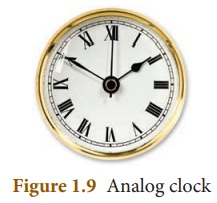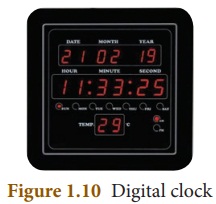Measurement | Chapter 1 | 8th Science - Questions Answers | 8th Science : Chapter 1 : Measurement
Chapter: 8th Science : Chapter 1 : Measurement
Questions Answers
TEXTBOOK EXERCISES
I. Choose the best
answer.
1. Which one the following
systems of unit is the British System of unit?
a.
CGS
b.
MKS
c.
FPS
d.
SI
[Answer:(c) FPS]
2. Electric current is a
______quantity
a.
base
b.
supplementary
c.
derived
d.
professional
[Answer:(a) base]
3. SI unit of temperature is
______
a.
celsius
b.
fahrenheit
c.
kelvin
d.
ampere
[Answer: (c) kelvin]
4.
Amount of substance is
(a)
directly proportional to the number of atoms
(b)
inversely proportional to the number of atoms
(c)
directly proportional to the square of number of atoms
(d)
inversely proportional to the square of number of atoms
[Answer:
(a) directly proportional to the number of atoms]
5. Luminous intensity is the
intensity of______
a.
laser light
b.
UV light
c.
visible light
d.
IR light
[Answer: (c) visible light]
6. Closeness of two or more
measured values is called as ______
a.
accuracy
b.
precision
c.
error
d.
approximation
[Answer: (b) precision]
7. Which one of the following
statement is wrong?
a.
Approximation gives accurate value.
b.
Approximation simplifies the calculation.
c.
Approximation is very useful when little information is available.
d.
Approximation gives the nearest value only.
[Answer: (a) Approximation gives accurate value.]
II. Fill in the
blanks.
1.
The solid angle is measured in steradian.
2.
The coldness or hotness of a substance is expressed by temperature.
3. Ammeter is used to measure electric current.
4.
One mole of a substance contains 6.023 × 1023 atoms or molecules.
5.
The uncertainty in measurement is called as error.
6.
The closeness of the measured value to the original value is Accuracy.
7.
The intersection of two straight lines gives us plane angle.
III. State true or
false. If false, correct the statement.
1.
Temperature is a measure of total kinetic energy of the particles in a system.
Correct statement: Temperature is a measure of average
kinetic energy of the particles in a system.
2.
If one coulomb of charge is flowing in one minute, it is called ‘ampere’.
Correct statement: One coulomb of charge flowing per second
is called ‘ampere’.
3.
Amount of substance gives the number of particles present in a substance.
4.
Intensity of light coming from a candle is approximately equal to one
‘candela’.
5.
Quartz clocks are used in GPS devices.
6. Angle
formed at the top of a cone is an example for ‘plane angle’.
Correct statement: Atomic clocks are used in
GPS Devices.
7. The
number 4. 582 can be rounded off as 4. 58.
IV. Match the following.
1.
Temperature Closeness to the actual value
2.
Plane angle - Measure of hotness or coldness
3.
Solid angle - Closeness to two or more measurements
4.
Accuracy - Angle formed by the intersection of three or more planes
5.
Precision - Angle formed by the intersection of two planes
[Ans : 1
- b, 2 - e, 3 - d, 4 - a, 5 - c)]
1.
Temperature (b) Measure of hotness or coldness
2. Plane
Angle (e) Angle formed by the intersection of two planes
3. Solid
Angle (d) Angle formed by the intersection of three or more planes
4.
Accuracy (a) Closeness to the Actual Value
5.
Precision (c) Closeness to two or more measurements
V. Consider the statements given below and choose the correct
option.
a. Both assertion and reason are true and reason is the correct explanation of the assertion.
b. Both assertion and reason are true but reason is not the correct explanation of the assertion.
c. Assertion is true, but reason is false.
d. Both assertion and reason are false.
1. Assertion:
The SI system of units is the suitable system for measurements.
Reason:
The SI unit of temperature is
kelvin.
[Answer: (b) both
assertion and reason are true but reason is not the correct explanation ' of
the assertion]
Correct explanation: In
SI system the units are precisely defined and have the same value everywhere.
2. Assertion: Electric current, amount of substance, luminous intensity are the
fundamental physical quantities.
Reason:
They are independent of each other.
[Answer: (a) both assertion and reason are true and reason is the
correct explanation of the assertion]
3. Assertion: Radian is the unit of solid angle.
Reason:
One radian is the angle subtended at the centre of a circle by an arc of
length equal to its radius.
[Answer: ★ Assertion is false, but reason is true]
Correct explanation: Radian is the unit of plane angle.
VI. Answer very briefly.
1. How many base quantities are
included in SI system?
Answer: Seven.
2. Give the name of the instrument
used for the measurement of temperature.
Answer: Thermometer.
3. What is the SI unit of luminous
intensity?
Answer: Candela (cd).
4 What type of oscillations are used
in atomic clocks?
Answer: Periodic vibrations.
5. Mention the types of clocks based
on their display.
Answer: Analog clock and digital clock.
6. How many times will the ‘minute
hand’ rotate in one hour?
Answer: One time.
7. How many hours are there in a
minute?
Answer: 60 minutes = 1 hr
1 minute = 1/60 = 0.0167 hours.
VII. Answer briefly.
1. What is measurement?
Answer: Measurement is the process of finding an unknown physical quantity by
using a standard quantity.
2. Define - Temperature.
Answer: Temperature is a measure of the average kinetic energy of the particles
in a system.
3. Define - Ampere.
Answer: One ampere is defined as one ‘coulomb’ of charge moving in a conductor
in one second.
4. What is electric current?
Answer: The magnitude of an electric current is the amount of electric charges
flowing through a conductor in one second.
5. What do you mean by luminous
intensity?
Answer: The measure of the power of the emitted light, by a light source in a
particular direction, per unit solid angle is called as luminous intensity.
6. Define - Mole.
Answer: Mole is defined as the amount of substance, which contains 6.023 × 10
23 entities.
7. What are the differences between
plane angle and solid angle?
Answer: Difference between Plane Angle and Solid Angle :

Plane
Angle
• Angle between the intersection of two lines or planes.
• It is two dimensional
• Unit is radian.
Solid
Angle:
• Angle between the intersection of three or more planes at a
common point.
• It is three dimensional.
• Unit is steradian.
VIII Answer in detail.
1. List out the base quantities with
their units.
Answer: Base Quantities and Units:

2. Write a short note on different
types of clocks.
Answer:
Types of clocks based on display:
(i) Analog clocks
(ii) Digital clocks
(i) Analog
clocks : It looks like a classic clock. It has
three hands to show the time.

(1) Hours
Hand : It is short and thick. It shows
‘hour’.
(2) Minutes
Hand : It is long and thin. It shows
‘minute’.
(3) Seconds
Hand : It is long and very thin. It shows
‘second’. It makes one rotation in one minute and 60 rotations in one hour.
Analog clocks can be driven either mechanically or
electronically.
(ii) Digital
clocks :
(1) A digital clock displays the time directly. It show's the
time in numerals or other symbols. It may have a 12 hours or 24 hours display.

(2) Recent clocks are showing Date, Day, Month, Year,
Temperature etc.
(3) Digital clocks are often called as Electronic Clocks.
Different
types of clocks based on working mechanism :
(i) Quartz
Clock:
(1) These clocks are activated by ‘electronic oscillations’,
which are controlled by a ‘quartz crystal’.

(2) The frequency of a vibrating crystal is very precise. So,
the quartz clock is more accurate than the mechanical clock.
(3) These clocks have an accuracy of one second in every 109
seconds.
(ii) Atomic
Clock:
(1) These clocks are making use of periodic vibrations occurring
within the atom.
(2) These clocks have an accuracy of one second in every 1013
seconds.

(3) Atomic clocks are used in Global Positioning System (GPS),
Global Navigation Satellite System (GLONASS) and International time
distribution services.
IX Higher Order Thinking Question.
1. Your friend was absent to school
yesterday. You are enquiring about his absence. He told that he had fever and
it was measured to be 100°C. Is it possible to have 100°C fever? If he is
wrong, try to make him understand.
Answer: (i) No. It is not possible of 100°C fever. The normal
temperature of human body is between 98.4°F and 98.6°F.
(ii) So, he should say that, he was affected by a fever of 100°F
and it is not 100°C.
Related Topics